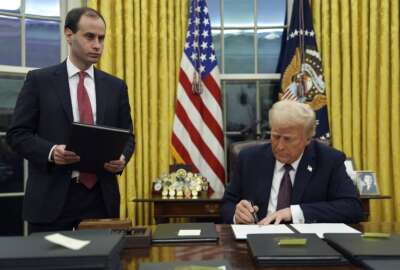Insight by Amentum
Capabilities and applications expand for autonomous and unmanned systems
The unmanned systems of today will rapidly evolve into multi-function platforms marked by autonomy and the capability of operating in concert with other crewed and...
Expect fast progress in the domain of unmanned, remotely piloted systems. The unmanned systems of today will rapidly evolve into multi-function platforms marked by autonomy and the capability of operating in concert with other crewed and non-crewed systems.
That’s according to Tim Saffold, executive vice president of autonomous and unmanned systems for the Engineering, Science and Technology business group at engineering services provider Amentum which supports a broad portfolio of autonomous, unmanned, and counter-unmanned capabilities.
“The traditional roles of these systems have been pretty much intelligence, surveillance and reconnaissance; gathering information that supports the various services and the missions they need to accomplish,” Saffold said. Now they’ve also become strike platforms that can deliver kinetic effects against adversaries.
“Where are we going today is more of a collaborative approach, where you see the systems starting to work together,” Saffold said. Self-directing autonomy will be aided by the data a vehicle is able to collect from its own sensors and from nearby systems. Key to effective use of autonomy, he added, will depend on making the right decisions on what functions can appropriately operate without human intervention, such as rerouting around obstacles, and which functions, like the decision to fire a weapon, will stay reserved for people.
UAS for infrastructure
Saffold said autonomous systems and platforms have growing importance domestically, and not just for overseas defense applications. In particular, operators of critical infrastructure use unmanned systems for surveillance, security and maintenance. He cited one example in which a hovering drone equipped with cameras performed a vertical inspection of a chimney stack.
“We designed a vertical lift, unmanned system that could inspect and map the outside of the chimney,” Saffold said. It could “lower into the chimney [with] a camera device that was spatially oriented in a way that it could map the interior of that chimney.”
He said this technique avoided the need for weeks of cranes, scaffolding construction and of sending a person in a hazmat suit down a dangerous shaft.
“We were able to do something that turned several months of activity into three days of activity,” Saffold said.
Much critical infrastructure is linear, such as railroad tracks, power lines or pipelines. Saffold said operators are using AUS more and more for faster and more efficient inspections of linear infrastructure than humans can perform.
This approach brings an added benefit in the form of richer data for analysis of trends in corrosion, cracks or whatever phenomenon infrastructure operators deem important to observe.
Such inspection “allows the assimilation of more accurate data over time in such a way that you have an archive,” Saffold said. “You can make decisions going forward. And if you need to research you can go back and see where you’ve been, and then make decisions on where you need to go.”
Amentum has worked with the Tennessee Valley Authority on dam inspections, flying unmanned ariel vehicles into difficult areas for mapping and “collecting data collecting imagery,” Saffold said. “The engineer is looking at it and making on-site decisions with regard to what needs to be done with maintenance.”
Environmental surveillance
A third area in which new AUS technologies apply is surveillance and measurement of the natural environment, especially as climate and climate change mitigation questions rise in importance. Saffold said miniaturization of sensors makes them lighter and less power hungry. That in turn makes them more suitable to the long deployments environmental surveillance requires.
“What is most relevant in this climate discussion?” Saffold said. “It’s measured change. If you can’t measure the change with accurate data, then you don’t really know what it is you should be doing to be able to affect the change.”
He added, “Unmanned systems can come in – air, land and sea – and help you collect high quality data in terms of imagery or other aspects that can help you map, see and understand what’s going on with regard to climate change.”
In one instance, Amentum teams worked near the Arctic Circle to measure ice flow and melt with multispectral sensors on unmanned systems, all in harsh environments. Saffold said AUS can gather data either from their own on-board sensors, or they can collect data from fixed-location sensors. Ground and water operated unmanned vehicles can use tethered sensors. In other words, properly engineered and integrated unmanned systems offer wide versatility for data collection, Saffold said.
Regardless of the application, Saffold said, both government and private sector organizations will have the most success if they use unmanned systems not to replace people but rather to augment their tasks with the kind of automation-induced efficiency that frees people to do higher level work.
“Many might think, ‘Hey, this is we’re going to replace x number of personnel with this one system,’” Saffold said. “But what we find over time is that it’s more effective and more efficient when it augments.”
Copyright © 2025 Federal News Network. All rights reserved. This website is not intended for users located within the European Economic Area.
Related Stories
Senate confirms Marco Rubio as secretary of state, giving Trump the first member of his Cabinet
Featured speakers
-

Tim Saffold
Executive Vice President, Autonomous and Unmanned Systems, Engineering Science and Technology strategic business unit, Amentum
-

Tom Temin
Host, The Federal Drive, Federal News Network
Upcoming Events
Related Stories
Top Stories

Tim Saffold
Executive Vice President, Autonomous and Unmanned Systems, Engineering Science and Technology strategic business unit, Amentum

Tom Temin
Host, The Federal Drive, Federal News Network
Tom Temin has been the host of the Federal Drive since 2006 and has been reporting on technology markets for more than 30 years. Prior to joining Federal News Network, Tom was a long-serving editor-in-chief of Government Computer News and Washington Technology magazines. Tom also contributes a regular column on government information technology.






